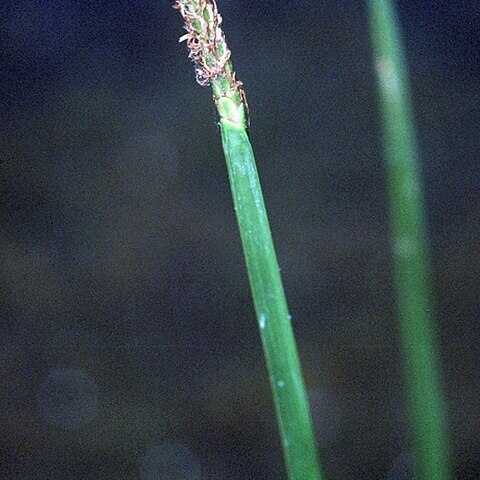Plants perennial; rhizomes 1.5–4 mm thick, soft to hard, longer internodes 3–8 cm, scales 5–10 mm, tubers absent. Culms acutely quadrangular, (30–)45–105 cm × (1–)2–5.4 mm, soft to firm, internally spongy, transverse septa incomplete; plants never forming filiform, flaccid culms. Leaves: distal leaf sheaths persistent, membranous, apex narrowly acute to acuminate, sometimes prolonged into a bladelike portion to 8 cm. Spikelets not proliferous, (15–)20–76 × 3–5(–6) mm; rachilla joints bearing obscure winglike remnants of floral scales; proximal scale empty, amplexicaulous, (1–)2.2–5.4 mm; floral scales (28–)45–135, 2–3 per mm of rachilla, stramineous to pale brown, usually with pale to dark brown submarginal band, midrib region sometimes greenish, broadly obovate to ovate, (4–)4.5–6.2 × 2.8–5 mm, subcartilaginous, apex rounded to obtuse. Flowers: perianth bristles 6–7, whitish to brown, slender, often markedly unequal, shorter than achene or some equalling tubercle, sparsely retrorsely spinulose to smooth; anthers stramineous to red-brown, 2.3–2.9 mm; styles 3-fid, sometimes 2-fid. Achenes yellow or pale green to brown or purplish, biconvex, obovoid to obpyriform, 1.8–3 × 1.3–2 mm, almost smooth to markedly sculptured at 10–15X, each face with 19–38 rows of almost linear, transversely elongated cells, which are sometimes isodiametric at achene base, apex often constricted to neck 0.3–0.4 mm wide. Tubercles dark brown or whitish, deltoid to high-pyramidal or lanceoloid, 0.7–1.5 × 0.4–1 mm, often spongy.
More
Cespitose and rhizomatous perennial; stems stout, to 1 m, 2–6 mm thick, sharply quadrangular; spikelet cylindric, (1.5–)2–5 cm, about as thick as the stem; scales in 4 rows, elliptic to obovate, 5–6 mm, broadly rounded, scarious-margined; bristles equaling or surpassing the achene; style bifid or trifid; achenes biconvex, obovoid, brown, 2–3 mm, constricted to an urn-shaped neck, marked with vertical rows of transversely elongate cells; tubercle dark, flattened, a third to half as long as the achene. Shallow water; Mass. to Wis., s. to Fla. and Mex., commoner southward.

